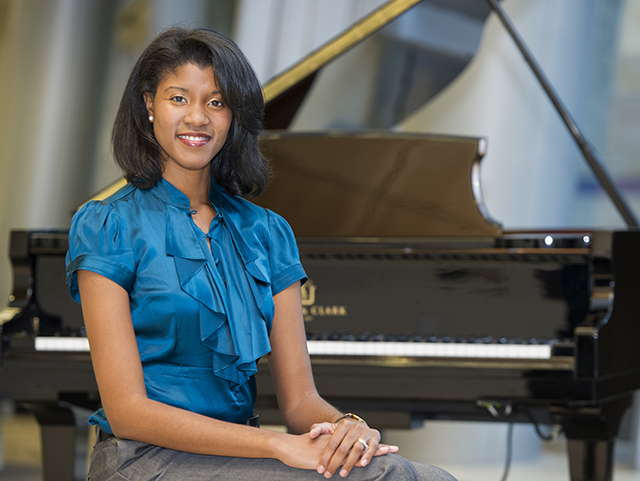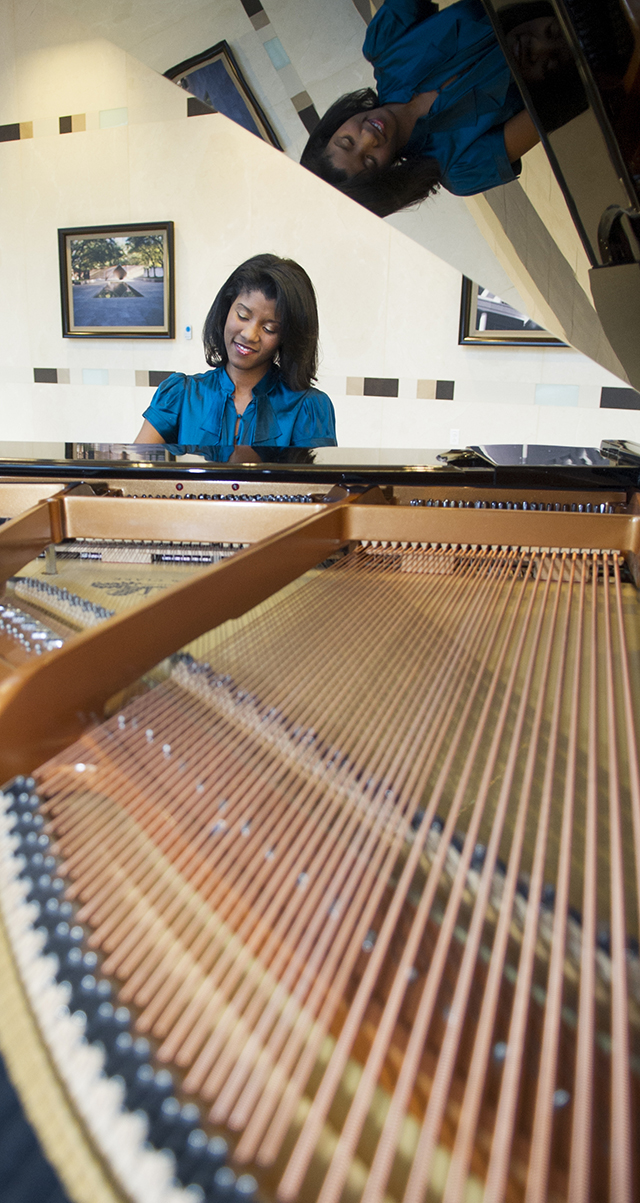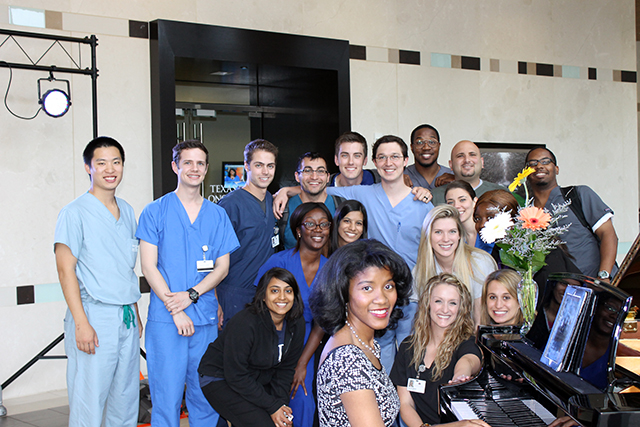Chords of healing

As a third-year dental student at Texas A&M University Baylor College of Dentistry, most of Ashley Smith’s days are spent treating patients in the clinic. On the rare occasion Smith is gifted with a bit of spare time, she knows exactly what to do: Stride down the hall of the college’s first floor to where TAMBCD and Baylor University Medical Center intersect. Take the hospital elevator to the second floor, and breeze through the sky bridge to the Baylor Charles A. Sammons Cancer Center. Grab the keys hanging in the mezzanine-level office, and descend the stairs to the lobby. Sit at the bench, and crack open the baby grand.
 When Smith’s hands glide across the keys, the number of listeners can swell to nearly 2,000 throughout the duration of any given performance, according to Benny Barrett, volunteer coordinator for the hospital’s Healing Arts Program, in which music is brought to cancer patients and their families in open-air, informal settings.
When Smith’s hands glide across the keys, the number of listeners can swell to nearly 2,000 throughout the duration of any given performance, according to Benny Barrett, volunteer coordinator for the hospital’s Healing Arts Program, in which music is brought to cancer patients and their families in open-air, informal settings.
“If you sit down by Ashley when she is on the piano, and you look up, people will be shoulder to shoulder on the balcony above,” Barrett says. “On chemo day, patients can walk around with their pumps. You’ll literally see 14 to 30 people with their pumps, leaning over, looking.”
Smith — who has played classical piano since she was 5 — parlayed her affinity toward the Sammons Center’s calming environment into a volunteer music gig in spring 2014. She was eating lunch at the center’s cafe when the sound of the piano on auto-play caught her attention. She asked around, discovered Barrett’s name and inquired if the program needed another volunteer musician.
“I said, ‘That’s great, can you play?’” recalls Barrett, who suggested an impromptu audition at the chapel piano downstairs. “Eight bars into it, I was ready to put her on the schedule.”
Volunteers play for two-hour sets, and Smith signs up for those slots when summer breaks permit. Clinic and dental school coursework consume most of her time, so she and Barrett have a new agreement: Whenever Smith has time, whether it’s for 10 minutes or 45, all she needs to do is take the keys from his office, unlock the piano and play.
The time is as valuable to Smith as it is to the patients and their families.
“With dentistry, we’re working with our hands doing these skills we have never done before,” Smith says. “When I play piano, it reminds me I am in control of my hands. It makes me remember I can do this. I take that feeling back to the clinic, back to the lab. I feel like it trains my hands to do what my brain wants it to do. It helps my hands build the manual dexterity needed for dental work.”
The foundations for Smith’s love of piano were laid during her childhood in Pine Bluff, Ark. Her mother, the choir director at their church, encouraged Smith to play and signed her up for lessons. Soon enough, Smith was teaching classmates and performing during children’s mass at her school. By the time high school rolled around, she played piano during Sunday services.
These days, Smith branches out from her classical environs and gravitates toward modern music including ballads, inspirational pieces and songs with religious undertones.
“My focus is to give cancer patients hope and relaxation, to give them a break from what they may be going through,” says Smith. “I could only imagine having to wait for those appointments. Waiting to hopefully get good news. It’s kind of scary, with what to expect, and to have to sometimes wait hours for that kind of an appointment.”
Back in the dental clinic, a refurbished iPod, some headphones and a Spotify app allow Smith to introduce the calming effects of music during appointments. Her patients can listen to their preferred genre throughout their care.

She may be on to something.
The Healing Arts program at Baylor University Medical Center — also home to medical students as part of the Texas A&M Health Science Center Dallas campus — is one of several success stories nationwide. Inspired from established music therapy models at the Cleveland Clinic and New York’s Memorial Sloan Kettering Cancer Center, the Sammons program includes bedside music performance for inpatients, provided by a certified staff musician when the treating physician prescribes.
Volunteer musicians like Smith help fill in the gaps to create a healing environment within the entire building. The music helps boost coping skills, relaxation, and distraction from pain while reducing anxiety. Patients and family members alike can benefit from the sweet strains and melodies, whether they are at the center for treatment or diagnostic services.
Barrett witnesses the program’s impact every day.
“Walking off that elevator, people are just in a daze,” Barrett says. “They’ll sit down and just dissolve into tears or get that thousand-yard stare. Thirty minutes later, they’re essentially kissing the feet of the performers, thanking them for getting them through that first initial period.”
Upcoming performances at the Baylor Sammons Cancer Center:
- October 15, Nigel Newton–Vibraphone
- October 17, Merry Miller–Harp
- October 20, Sorta Sisters–Trio Singers (Sammons Lobby)
- October 21, Margie Ruzicka–Piano (Sammons Lobby)
- October 22, Charley Lee–Singer/Guitarist
- October 23, Mark C. Lowe–Sitar
- October 24, Ben King–Strings/Flutes (Bridge of Hope)
- October 24, Lake Highlands Song Birds (Sammons Lobby)
- October 27, Merry Miller–Harp
- October 29, Nigel Newton–Vibraphone
Performances begin at 11 a.m. and last until 1 p.m.
— Jenny Fuentes